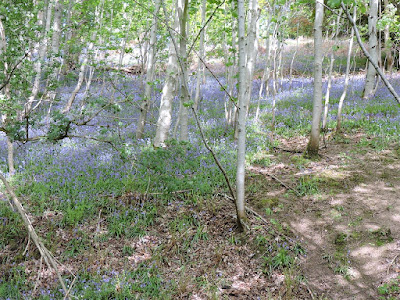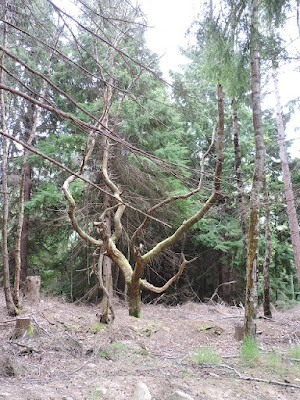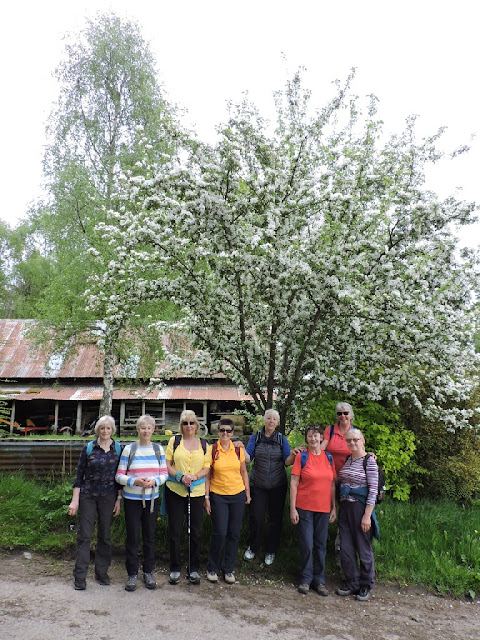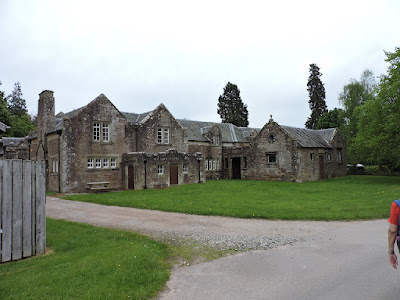HAM HAUGH, AVOCH, NO, ROSEHAUGH!
Another month and another walk, this time around the Rosehaugh Estate, near Avoch. The sun was shining as we gathered in the car park that hadn't been given to us in our pre walk email instructions. Most people went to this car park, on the right before the co-op. The instructions were to find a car park up the road on the left, just before the co-op. I followed the instructions and did not find the car park! Others found the car park, but clearly had not read the instructions or just ignored them. It is hard to see how anyone comes out of this with any credit.
Here we are milling about waiting for everyone to arrive, well, waiting for Agnes, actually.
Not only was the sun shining, but the sky was blue and the swallows were on the wing and the wire. It must be summer.
From the car park, we crossed the road to start up the hill. We passed the bus stop, which is in the form of an upturned boat. I have shown photos of this in the past, so didn't take any this time. However, I had never noticed the fired clay tablets inside the shelter containing all sorts of little messages made by local people and organisations. A clever wee idea, and much better than the utilitarian plastic shelters you commonly see.
Avoch has long been a fishing village and the Gaelic name means place of the stream. The Avoch Burn cuts the village in two. The tiles make reference to water mills and fishing for herring.
Off we went, up the hill.
Then, into Rosehaugh Estate.
Passing a fairy house on the way.
There were banks of bluebells.
A giant sequoia tree, sometimes called giant redwood or Wellingtonia. If Joe Blogs has difficulty with naming the tree, this is nothing to the scientific community, who got it wrong a number of times. For the most massive tree on the planet, this must be a bit off.
It was thought that the name sequoia was a tribute to Sequoyah. He was a native American polymath, who invented the Cherokee syllabary. So what, you might think, but this, in fact, was one of the first times in recorded history that an illiterate person created an original writing system. Until he did that in 1821, the Cherokee peoples could neither read nor write.
However, he was only partly honoured by the name of the tree. The name was thought to have been devised by an American, but it turned out that the man responsible was an Austrian linguist and botanist, who admired Sequoyah, but also noted that the number of seeds per cone came directly in sequence with those of the other trees in the suborder of the species. Thus he could use the Latin sequi, meaning to follow, if you are still following me!
If you think that's fascinating, wait until you read the next bit!
As with all these sorts of things, the assumption is that nothing existed until it was discovered by Europeans, but, of course, the native Americans knew the trees forever and they had their own names for them. The first European reference to these giant trees was in 1833, but they were not named until 1853 by an English botanist, who called them Wellingtonia gigantia. However, the name Wellingtonia had already been used, so this was invalid, but it is common to hear these trees described as Wellingtonia to this day. In the next year another botanist tried Sequoia gigantia, but this had already been used for the Coast Redwood. Next up was Washingtonia californica, but that failed because Washingtonia was the name of a type of palm. Another try was to name it after the fossil tree known as Steinhauera, but there was considerable doubt over whether the live tree was actually related to the fossil, so this became invalid as well. Eventually an American botanist pointed out that the giant sequoia was distinct from the coast redwood and coined the name Sequoiadendron giganteum. It had taken 86 years from the time of the first naming to get it right.
Amazing, eh?
The Burnt House. A very strange name for a house, that clearly isn't burnt. However, it actually was burnt, but this is isn't it. Confused? There was a great house here called Avoch House and this burnt down in 1833. This building is part of the west service range of the burnt down Avoch House, which survived the fire. Avoch House was never rebuilt, so this is all that remains of it. So, it was the unburnt part of the larger burnt house.
We had gained a wee bit of height, so that allowed for some nice, but hazy, views over the surrounding countryside.
There were also sights to be seen down low as well. Now, I think we thought at the time that this was a 5 spot ladybird, but I don't think that can be the case. Firstly, the 5 spot ladybird was thought to be extinct and is now only found in a very specific habitat - river shingle. Secondly, it has never been recorded in the Black Isle. I think it must be a 7 spot ladybird, the most common type in the country. I suspect the missing spots are just hidden round the wing case and cannot be seen from this angle.
As for this, I have not seen it before, but it might well be Asiatic Pennywort, a highly invasive non-native species, with many culinary uses in the the far east. We could have eaten it, if my identification is correct. If not, who knows what the consequences might have been.
More bluebells.
This is Gardens House and it belonged to the original Rosehaugh Estate. It was once a nice little cottage, but the addition of the service range some time after the house was built in 1845 has ruined it somewhat. The modern extension, which, happily, I did not photograph, has completely ruined it.
I think even the wee man in the garden has averted his eyes from the house.
Part of the old Rosehaugh Estate walled garden. The garden was really quite huge and is reputed to have included a mile of ornate glass houses and a semi underground palm house.
A group of people looking in different directions.
The characteristic flower candles of the common Horse Chestnut tree. They are called Horse Chestnuts because the seeds, or conkers were once thought to be a cure for panting or coughing horses.
The chestnuts are in full leaf, whilst this poor specimen appears to be standing dead or at least a bit on the skeletal side.
Adjacent to the kennels is this octagonal deer larder. It is quite unusual in design and is probably quite lucky to have survived to the present day, having likely been built in the 1860's.
This is the adjacent gamekeeper's house and kennels, dating from the 1840's. They were part of the improvements made to the estate by Sir J J R MacKenzie, who was the last of the MacKenzie family to own Rosehaugh Estate.
A group photo of some flowers under the blossom.
Round the corner of the house is an unusual porch and wing set diagonally to the main house. It is thought that these might be a later addition to the original.
The bins are an even later addition.
An unusual sign. We didn't see any horses here, although there was one on the road when we stopped for lunch. I don't know if this sign applies to horse riders or whether you have to chase any horses you might come across on the grass, which is where you normally find horses.
We made a short detour to walk up to a mausoleum in the trees.
This is the graveyard for James Douglas Fletcher, who died in 1927 and his wife Lillian Maud Augusta Stephen, who died in 1955.
Fletcher's father bought the estate and the house in 1864 from J J R MacKenzie for £145,000. James Douglas Fletcher inherited the property in 1885.
JDF was immensely rich, with estates in Ceylon and South Africa. He made fortunes in tea and rubber and was very generous with his money, particularly in Avoch and surrounding area.
The mausoleum was designed by Sir Edwin Landseer Lutyens in 1928. He is sometimes described as the greatest ever British architect. He got about a bit, designing much of New Delhi, as well as the British Embassy in Washington, for instance. He also designed the Cenotaph in London. This mausoleum is his most northerly surviving commission in the British Isles.
Robin and Hugh not looking at a bit of architectural heritage.
The girls were not too sure.
Truth be told it was all a bit brutal in appearance. Indeed, one architectural critic said that the genius and the charlatan were very close together in Lutyens.
So, we marched back down the hill to continue on the walk.
Gray's Cottage. This was built about 1900 and was used to house Fletcher's valet, a Mr Gray. This is one of many buildings around the estate built as part of a huge modernisation.
Is this Mr Gray, the valet?
A fine body of men, who, truth be told, look like they could use the services of a valet.
For such a nice house, you might have expected the library to have been indoors.
The next architectural gem was the Stables. These had been remodelled by Alexander Ross in 1874. He was probably the most famous architect operating in Inverness, He had been born in Brechin and moved to Inverness in 1838. Among his most famous buildings are the Cathedral and the Bishop's Palace at Eden Court. He carried out a number of improvements at Rosehaugh. However, many of these works were then reworked again by William Flockhart between 1898 and 1903.
Lunchtime. What more can I say?
Lunch was on the site of the demolished Rosehaugh House. There had been a house on the site for centuries and Alexander Ross had done some remodelling work, but it was clearly not up to scratch. In 1890, Fletcher was unmarried and had taken a bit of a shine to Nellie Bass, who was the heiress to the Bass brewing fortune. Who wouldn't?
In any event she is reputed to have said that her father provided better accommodation for his horses. So, he didn't marry her, but he did commission Flockhart to remodel the house at the turn of the century.
There is next to nothing left of the house itself. The buildings behind the dinosaurs are actually the remains of the wine cellars.
This is the terrace of the house, which stood where the photograph was taken from. It was enormous and ostentatious.
You can see just how grand it was from the photo below.
Fletcher married Lilian Stephen in 1909. She had lived in India and her father was Sir Fitzroy Charles Dalhousie Stephen. Lilian died in 1955 and she and Fletcher had no heirs. Nobody in the wider family wanted the estate and it was sold. All the contents of the house were sold in what is thought to have been the biggest house clearance on the Black Isle. The house was sadly demolished in 1959.
All that remains are the vestiges of the gardens. What a shame. The house had a heated pool, a Turkish bath and an Italian drinking fountain all housed under a great blue dome. The whole house was heated by a great steam engine which blew hot air throughout the property and used a ton of coal a day! The grounds had badminton courts, a horse racing course, artificial lakes and croquet lawns.
Hugh proving that he can get dressed all by himself, as we prepare to leave the absent grandeur of the house that we didn't really know about while we were eating our egg rolls.
Next stop was the fascinating dairy. This was built in 1907 and was intended to supply milk, cream and cheese to the main house and to estate workers. It also provided these to the village of Avoch during war years.
The dairy and the attached dairyman's cottage were built in 1907 in the Arts and Crafts style. The house was connected by a corridor to cheese and cream rooms, and a milking parlour adjacent to a covered yard. Remarkably, many of the original fixtures and fittings are still in place and you can wander round the inside, so we did. It was fascinating.
From the dairy, it was time to head for the cars, giving us some nice views out to the Firth.
Having been to the dairy, it was time for tea to go with the milk. That had been arranged at Munro's. There had been a bit of a run on the cakes, so choice was a bit limited, but nobody starved.
Although Charlie looks like he didn't get the scone that he wanted.
That was the end of a fascinating walk that I am sure we all enjoyed.
Many thanks to Sue and Charlie for all the organisation.


























































